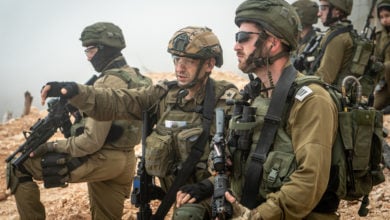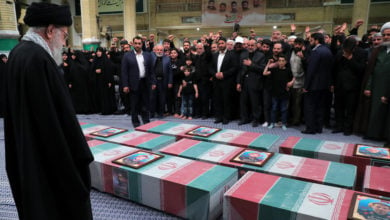A situation of dual power exists in Lebanon today. There are two counterposed sources of authority and power in the country. Although Lebanon is a small country with a population of barely four million people, it has become a central battleground between the contending camps in the Middle East. The outcome of the conflict could have a profound impact on the future of the region.
On the one side is the government of Prime Minister Fouad Siniora, the general staff of the Lebanese army, and an
|
Another Arab leader who has sided with Siniora is Mahmoud Abbas, president of the Palestinian Authority. Abbas’s position contrasts sharply with the sentiments of the vast majority of Palestinian people, including most of his own Fatah organization.
Confronting the pro-imperialist forces is an alliance led by Hezbollah, which inflicted a stunning blow on the U.S.-armed Israeli military in the 34-day war this past summer. This alliance is demanding the formation of a new “national unity” government. It includes the mainly Christian Free Patriotic Movement, the Lebanese Communist Party, and Amal, which, like Hezbollah, draws most of its members from the Shia community. Standing with this alliance are the governments of Syria and Iran, the popular resistance forces in occupied Palestine and Iraq, and public opinion—often referred to as “the Arab street”—throughout the region.
On Dec. 1, more than one million people, or at least a quarter of Lebanon’s population, answered the call of the Hezbollah-led coalition and rallied in Martyrs’ Square in Lebanon’s capital, Beirut. For the past seven days, thousands and often tens of thousands of people have camped out in the center of the city, vowing to remain until the old government resigns and a new one is formed.
The position of Hezbollah and its allies was greatly strengthened by the outcome of last summer’s war and the capacity of Hezbollah’s military wing to defend the country against the vaunted Israeli army.
Confessional system favors the rich
Under Lebanon’s undemocratic confessional system, all seats in the parliament are apportioned according to religious sect. The president must always be a Maronite Catholic, the prime minister a Sunni Muslim and the speaker of the parliament a Shia Muslim. In addition, the top command post in the Lebanese army is reserved for a Maronite.
This system was created by the French colonizers and elite elements of the Catholic and Sunni communities in 1943. It
|
Today, it is estimated that Muslims make up at least 70 percent of the population. Shias, the largest and poorest sector of Lebanon, constitute 35-40 percent of the total. Yet, only one small adjustment has ever been made in the parliament, so that now there is an even 64-64, Christian-Muslim division of seats. The confessional system was designed from the start to protect the interests of foreign powers and the rich of the 18 officially recognized ethno-sectarian communities against Lebanon’s workers and peasants.
The abolition of the reactionary confessional system was one of the central demands of the progressive forces in the Lebanese civil war in the 1970s.
Ending the extreme inequality in the system is one of the main issues underlying the mass protests in Beirut today. A central demand is to create a new government that is more representative of the population. In particular, the leaders of the protests are insisting that their alliance must have at least one-third of the seats in the cabinet. A vote of one-third of cabinet ministers can block any government decision.
In a major speech broadcast throughout much of the Middle East, Hezbollah’s general secretary, Hassan Nasrallah, called for another mass demonstration on Dec. 10. “At the mass protest on Sunday we will show that those who are betting on our surrender are having an illusion,” he said. “Our people do not give up, do not get tired. We will not go out of the streets before we achieve our objective to save Lebanon … We will not be dragged into any strife even if you kill a thousand of us. We will not raise weapons in the face of anyone. … Our weapons are only for our Israeli enemy.”
Strengthened resistance movements
The struggles taking place across the Middle East are indeed “inextricably linked,” in the words of the Baker-Hamilton Iraq Study Group (ISG). The “grave and deteriorating” position of the U.S. military occupation in Iraq has weakened imperialism’s grip on the region. The real aim of the ISG, a bipartisan body of the ruling class politicians, is to prevent this serious setback from becoming a catastrophic defeat for U.S. imperialism in the Middle East.
In the aftermath of the spring 2003 invasion of Iraq, U.S. leaders believed that they could march on to achieve regime change in Syria, Lebanon and Iran. But the setbacks dealt to the U.S. government in Iraq and to Israel in Lebanon by popular forces have turned the imperialist hopes into their opposite and emboldened resistance movements regionally.
Top U.S. leaders, like secretary of state Condoleezza Rice, vice president Dick Cheney and president Bush, have all visited Jordan in the last month. The visits are a clear sign of worry. Propped up by the United States, Britain and Israel, the Jordanian monarchy holds power through a vicious police-state apparatus. But the Jordanian state is artificial with inherent weaknesses, and the country’s population is more than 60 percent Palestinian refugees. Opposition movements are growing inside Egypt, Saudi Arabia, Bahrain and other western-dependent Arab states. And despite bombing, assassinations and economic strangulation, the Palestinian resistance remains resolute.
In this setting, the outcome of the Lebanese struggle holds great importance not only for the people of that country, but for the entire region and beyond.
Click here to read more from PSL about Lebanon and the Middle East.








